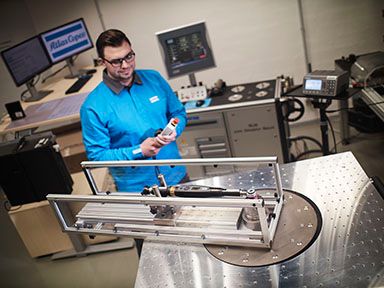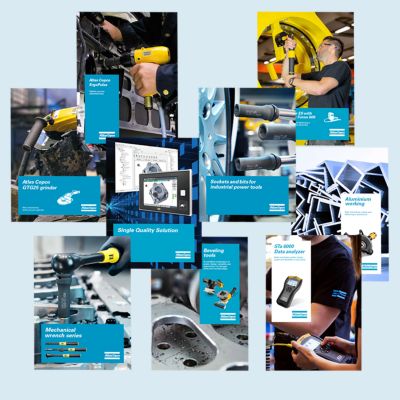Variant 1: Two layer stack – no clearance hole
- Two layer stack
- Direct joint, no clearance hole
- Materials: Steel 1.5 mm / Aluminum 2.5 mm
- Fastener: M5x20 external torx
- Adhesive between steel and aluminum
- Two layer stack
- Direct joint, no clearance hole
- Materials: Steel 1.5 mm / Aluminum 2.5 mm
- Fastener: M5x20 external torx
- Adhesive between steel and aluminum
Variant 2: Two layer stack – clamping part with clearance hole
By using a clamping part with clearance hole, thicker stack-ups with up to four layers can be joined with flow drill fastening. The upper layer can be aluminum or even high-strength steel (HSS). Since no upcoming material needs to be accommodated by the joining element, a cheaper flat head fastener can be used. However, the position of the robot is very important to exactly meet the clearance hole. If used with adhesive, a stitch bead application is recommended to avoid squeeze out.
This joint variant is suitable for body-in-white applications when the design of the car body does not allow direct joining. Also, it is used for applications where serviceability is a priority, for example when joining the cover to the tray in battery assembly for electric vehicles. Due to the clearance hole in the cover sheet, the cover can be easily disassembled and reassembled several times and remain leak tight.
By using a clamping part with clearance hole, thicker stack-ups with up to four layers can be joined with flow drill fastening. The upper layer can be aluminum or even high-strength steel (HSS). Since no upcoming material needs to be accommodated by the joining element, a cheaper flat head fastener can be used. However, the position of the robot is very important to exactly meet the clearance hole. If used with adhesive, a stitch bead application is recommended to avoid squeeze out.
This joint variant is suitable for body-in-white applications when the design of the car body does not allow direct joining. Also, it is used for applications where serviceability is a priority, for example when joining the cover to the tray in battery assembly for electric vehicles. Due to the clearance hole in the cover sheet, the cover can be easily disassembled and reassembled several times and remain leak tight.
- Two layer stack
- Clamping part with pre-hole
- Materials: Aluminum 2.0 mm / Aluminum 4.0 mm
- Fastener: M5x20 internal torx
- Two layer stack
- Clamping part with pre-hole
- Materials: Aluminum 2.0 mm / Aluminum 4.0 mm
- Fastener: M5x20 internal torx
Variant 3: Three layer stack – clamping parts with clearance holes
- Three-layer stack
- Clamping parts with pre-holes (first and second layer)
- Material: Steel 1.0 mm / Aluminum 2.0 mm / Aluminum 3.0 mm
- Adhesive between steel and aluminum
- Fastener: M5x20 internal torx
- Three-layer stack
- Clamping parts with pre-holes (first and second layer)
- Material: Steel 1.0 mm / Aluminum 2.0 mm / Aluminum 3.0 mm
- Adhesive between steel and aluminum
- Fastener: M5x20 internal torx
Variant 4: Two layer stack – no clearance hole – thinned-out cast
- Two-layer stack
- Direct joint, no clearance hole
- Materials: Casted aluminum 3.0 mm (1.5 mm thinned) / Steel 1.8 mm
- Adhesives between aluminum and steel
- Fastener: M5x20 external torx
- Two-layer stack
- Direct joint, no clearance hole
- Materials: Casted aluminum 3.0 mm (1.5 mm thinned) / Steel 1.8 mm
- Adhesives between aluminum and steel
- Fastener: M5x20 external torx
Variant 5: Two layer stack – no clearance hole – thick second layer
- Two-layer stack
- Direct joint, no clearance hole
- Materials: Steel 1.0 mm / Aluminum 4.0 mm
- Adhesives between aluminum and steel
- Fastener: M4x20 external torx
- Two-layer stack
- Direct joint, no clearance hole
- Materials: Steel 1.0 mm / Aluminum 4.0 mm
- Adhesives between aluminum and steel
- Fastener: M4x20 external torx
More information about our products and services:











